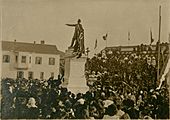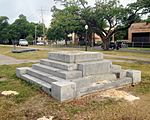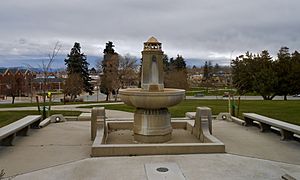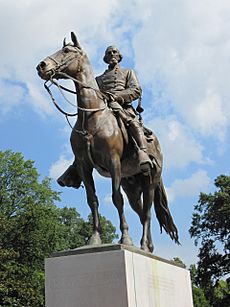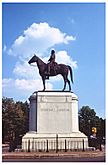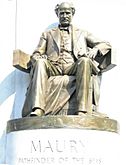Removal of Confederate monuments and memorials facts for kids
Confederate monuments and memorials are statues, flags, and other symbols that honor the Confederate States of America (CSA) and its leaders. The CSA was a group of Southern states that tried to separate from the United States between 1861 and 1865, leading to the American Civil War. A main reason for the Civil War was the Confederacy's desire to keep slavery.
Since the 1960s, many cities and towns in the United States have been removing these monuments from public places. Sometimes, like with the "Silent Sam" statue in North Carolina, protestors have even pulled them down themselves. The effort to remove these symbols grew much stronger after important events such as the Charleston church shooting in 2015, the Unite the Right rally in 2017, and the killing of George Floyd in 2020.
Many people believe these monuments celebrate white supremacy, which is the idea that white people are better than others. They also see the monuments as honoring a government that committed treason (betraying one's country) and whose main goal was to keep slavery going. For many African Americans, seeing these Confederate symbols more than a hundred years after the Civil War makes them feel unwelcome and unfairly treated.
Most Confederate monuments were built during the time of Jim Crow laws (from 1877 to 1964). These laws enforced racial segregation and discrimination. Critics say the monuments were not just memorials. Instead, they were built to scare African Americans and show that white people were still in charge after the Civil War. This is why the monuments have become a very political issue. Some Southern states have even passed laws to stop or make it harder to remove these public monuments.
After the killing of George Floyd in 2020, there was a new wave of Confederate monument removals. For example, the mayor of Birmingham, Alabama, broke a state law that prevented removing historical monuments. He said paying the fine was better than the unrest that would happen if the monument stayed. The Governor of North Carolina also had three Confederate monuments removed from the Capitol for public safety reasons. The U.S. Army announced it would rename military bases named after Confederate generals, and the U.S. Navy and U.S. Marines banned displaying the Confederate flag. This movement also spread outside the United States, leading to the removal of statues in places like England and Belgium.
Why Were These Monuments Built?

Most Confederate monuments were built during times of big racial conflict. This happened when Jim Crow laws were being put in place in the late 1800s and early 1900s. Another time was during the Civil Rights Movement in the 1950s and 1960s. These periods also marked 50 and 100 years after the Civil War. The most monuments were built between the late 1890s and 1920, with another smaller wave in the late 1950s and mid-1960s.
Historians say that in many cases, the monuments were not just to remember the past. They were meant to promote a future where white supremacy continued. One historian, Karyn Cox, called them "a legacy of the brutally racist Jim Crow era." Another historian, James Leloudis, noted that the people who paid for these monuments wanted to make the Jim Crow era seem right and to show that white men had the right to rule.
Adam Goodheart, a Civil War author, explained that these monuments are "20th-century artifacts." He said they were about creating a national unity that included Southerners but still left out black people.
A History of Removals

The removal of monuments became very noticeable with events in Louisiana and Virginia. In 2015, after the Charleston church shooting, the city of New Orleans decided to remove its Confederate memorials. They were taken down two years later. A few months after that, in August 2017, a state of emergency was declared in Virginia. This happened after a Unite the Right rally in Charlottesville against the removal of the Robert Edward Lee statue became violent, causing three deaths.
Other cities followed. In Baltimore, for example, the city's Confederate statues were removed overnight in August 2017 to keep the public safe. Similarly, in Lexington, Kentucky, the mayor asked the city council to move two statues from a courthouse.
In the three years after the Charleston shooting, Texas removed 31 memorials, more than any other state. The Southern Poverty Law Center reported that at least 114 Confederate monuments were removed from public spaces during that time.
A study from April 2020 found that Confederate monuments were more likely to be removed in places with many black and Democratic residents, where the NAACP had a local chapter, and where state laws allowed for removals.
| Time period | Number of removals (as of June 20, 2020) |
|---|---|
| 1865–2009 | 2 |
| 2009–2014 | 3 |
| 2015 (after Charleston church shooting) | 4 |
| 2016 | 4 |
| 2017 (year of the Charlottesville car attack) | 36 |
| 2018 | 4 |
| 2019 | 4 |
| 2020 (after killing of George Floyd) | 30 |
Who Supports Removing Them?
Many groups and individuals support removing Confederate monuments:
- The Make It Right Project started in 2018 to encourage the removal of these monuments.
- Protesters against the killing of George Floyd tore down the statue of Jefferson Davis in Richmond, Virginia.
- The "Take 'Em Down" conferences are held to plan and support efforts to remove the monuments.
- The Southern Poverty Law Center published a detailed report in 2016 about Confederate memorials and keeps an updated list online.
Who Opposes Removing Them?
In states like North Carolina and Georgia, where removing monuments is often against the law, protestors have sometimes pulled down Confederate monuments themselves.
- The Confederate Soldiers Monument in Durham, North Carolina, was pulled down.
- Silent Sam, a statue in Chapel Hill, North Carolina, was also pulled down.
- The Screven County Confederate Dead Monument in Sylvania, Georgia, was destroyed.
The first and third monuments were so damaged they couldn't be fixed. Silent Sam was not badly damaged and is currently stored while a decision is made about its future. The "Confederate Dead Monument" was later replaced with money raised by groups like the Sons of Confederate Veterans and the United Daughters of the Confederacy.
Also, the statue of Robert E. Lee in Fort Myers, Florida, was knocked over by unknown people in 2019.
Artistic Views
Artist Ben Hamburger has created a series of six paintings called Monuments. These paintings show monuments being taken down and moved away. Some of the monuments shown include Silent Sam, the Confederate Soldiers Monument in Durham, and the Jefferson Davis Monument in New Orleans.
Examples of Removals
Across the Nation
- Fort Bliss: Forrest Road, named after Confederate general Nathan Bedford Forrest, was renamed Cassidy Road in honor of a former post commander.
- U.S. Marine Corps: In 2020, the Marine Corps ordered the removal of all Confederate-related items, including flags and bumper stickers, from its bases.
Alabama
- Montgomery: In 2015, four Confederate flags were removed from the Confederate Memorial Monument after the Charleston church shooting.
- Birmingham: The Confederate Soldiers and Sailors Monument was removed in 2020, even though a state law tried to prevent it. The city paid a fine instead.
- Demopolis: A Confederate soldier statue was accidentally destroyed in 2016 when a police car crashed into it. The city later voted to move the damaged statue to a museum and put up a new memorial honoring both Union and Confederate soldiers.
- Mobile: A statue of Confederate Navy Admiral Raphael Semmes was removed in 2020.
- Tuscaloosa: The University of Alabama renamed Morgan Hall, which was named for a Confederate general, to the English Building in 2020.
Arizona
- Picacho Peak State Park: A wooden marker for Confederate volunteers was removed in 2015 due to damage. A brass plaque honoring Confederate soldiers was vandalized and removed in 2020 and will not be replaced.
Arkansas
- In 2017, the Arkansas Legislature stopped honoring Robert E. Lee’s birthday.
- In 2019, Arkansas voted to replace its two statues in the National Statuary Hall Collection in Washington, D.C. These statues were of a lawyer who supported the Confederacy and a white supremacist governor. They will be replaced with statues of singer Johnny Cash and civil rights activist Daisy L. Gatson Bates.
- Little Rock: Confederate Boulevard was renamed Springer Boulevard in 2015, honoring an African-American family.
California
- Confederate Corners: This town, renamed in 1868 after Southerners settled there, changed its name back to "Springtown" in 2018.
- Long Beach: Robert E. Lee Elementary School was renamed Olivia Herrera Elementary School in 2016.
- Los Angeles: The Confederate Monument in Hollywood Forever Cemetery was removed overnight in 2017 after activists called for its removal.
- San Diego: Robert E. Lee Elementary School was renamed Pacific View Leadership Elementary School in 2016. A marker for the Jefferson Davis Highway was removed in 2017.
District of Columbia

- U.S. Capitol: Statues of Confederate figures representing states have been or are being replaced. For example, Alabama's statue of Jabez Lamar Monroe Curry was replaced by Helen Keller in 2009. Virginia's statue of Robert E. Lee was removed in 2020 to be replaced by civil rights activist Barbara Rose Johns.
- Washington National Cathedral: Stained glass windows honoring Robert E. Lee and Stonewall Jackson were removed in 2017.
- In 2020, protestors pulled down the statue of Albert Pike, a Confederate general, and set it on fire. It was later taken away.
Florida
- State symbols: The shield of the Confederacy was removed from the Florida Capitol Rotunda in 2016. The Confederate battle flag was also removed from the official Senate seal.
- Bradenton: A Confederate monument was voted to be moved in 2017, but it broke during the move.
- Fort Myers: A bust of Robert E. Lee was found knocked down in 2019 and removed by the Sons of Confederate Veterans.
- Gainesville: A Confederate monument called "Old Joe" was moved from the courthouse lawn to a private cemetery in 2017.
- Hollywood: Streets named for Confederate Generals (Forrest, Hood, Lee) were renamed Freedom, Hope, and Liberty Street in 2018.
- Jacksonville: Nathan Bedford Forrest High School, named after a Confederate general, was renamed Westside High School in 2014.
- Lakeland: A Confederate soldier statue in Munn Park was moved to Veterans Park in 2019.
- Orlando: A Confederate "Johnny Reb" monument was moved from Lake Eola Park to a public cemetery in 2017.
- Tampa: The large Confederate flag at the privately-owned Confederate Memorial Park was removed by its owners in 2020 after threats to burn it. The Memoria In Aeterna monument was moved to a private cemetery in 2017.
Georgia
- State flag: From 1956 to 2001, the state flag of Georgia included the Confederate battle flag. The current flag uses a different version of the Confederacy's first flag.
- State Holidays: Georgia removed Confederate references from "Confederate Memorial Day" and "Robert E. Lee Day" in 2015; they are now called "State Holidays."
- Decatur: The DeKalb County Confederate Monument was removed in 2020 after a court order.
- Sylvania: The Screven County Confederate Dead Monument was pulled off its pedestal and badly damaged in 2018.
Indiana
- Indianapolis: In 2020, the Confederate Soldiers and Sailors Monument was removed from Garfield Park and taken apart.
Kansas
- Wichita: A Confederate Flag Bicentennial Memorial was removed in 2015.
Kentucky
- Frankfort: The statue of Jefferson Davis in the Kentucky Capitol Rotunda was removed in 2020.
- Lexington: The John C. Breckinridge Memorial and John Hunt Morgan Memorial were moved from the courthouse to Lexington Cemetery in 2017-2018.
- Louisville: The Confederate Monument in Louisville was moved to a riverfront park in Brandenburg, Kentucky, in 2016. The John B. Castleman Monument was moved to Castleman's burial site in 2020.
Louisiana
- New Orleans: In 2017, New Orleans removed several prominent Confederate monuments. The workers who moved them wore protective gear because of safety concerns and threats.
* The Battle of Liberty Place Monument, which celebrated a white supremacist group, was removed in 2017. * The Jefferson Davis Monument was removed in 2017. * The General Beauregard Equestrian Statue was removed in 2017. * The Robert E. Lee monument was removed in 2017. * Many public schools named after Confederate figures or slave owners were renamed in the 1990s. For example, Jefferson Davis Elementary became Ernest "Dutch" Morial School, and Robert E. Lee Elementary became Ronald McNair Elementary.
Maryland
- State of Maryland: A plaque was removed from the Maryland State House in 2020. The Sons of Confederate Veterans Commemorative License Plate featuring the Confederate battle flag was revoked in 2015.
- Baltimore:
* The Confederate Soldiers and Sailors Monument was removed in 2017. * The Confederate Women's Monument was removed in 2017. * Robert E. Lee Park was renamed Lake Roland Park in 2015. * The Stonewall Jackson and Robert E. Lee Monument was removed in 2017.
- Rockville: A Confederate Monument was moved from outside the Old Rockville Court House to private land at White's Ferry in 2017.
- White's Ferry: The ferry, formerly named Gen. Jubal A. Early after a Confederate General, was renamed in 2020.
Massachusetts
- Fort Warren: A memorial to 13 Confederate prisoners was removed in 2017.
Mississippi
- In 2020, the Governor signed a bill to remove the state flag (which included the Confederate battle flag) from all public buildings. Voters approved a new state flag later that year.
- Jackson: Davis Magnet IB School was renamed "Barack Obama Magnet IB School" in 2017.
- Oxford: Confederate Drive was renamed Chapel Lane. The University of Mississippi marching band stopped playing Dixie in 2016, and the school got rid of its Colonel Reb mascot in 2003.
Missouri
- Columbia: Robert E. Lee Elementary School was renamed Locust Street Expressive Arts Elementary School in 2018.
- Kansas City: A monument to Confederate women was removed in 2017.
- St. Louis: The Memorial to the Confederate Dead was removed from Forest Park in 2017. Confederate Drive was also removed and replaced with green space.
Montana
- Helena: The Confederate Memorial Fountain was removed in 2017.
New York
* Central Park: A monument to J. Marion Sims, a controversial surgeon and Confederate spy, was removed in 2018. * Brooklyn: A plaque honoring Robert E. Lee was removed from a tree he planted in 2017. * The Bronx: Busts of Stonewall Jackson and Robert E. Lee in the Hall of Fame for Great Americans have been ordered to be removed.
North Carolina
- Statewide: The North Carolina Department of Transportation stopped allowing special license plates with the Confederate battle flag in 2021.
- Asheville: Two Confederate monuments, including a Robert E. Lee marker, were removed in 2020. The Zebulon Vance Monument was covered and its future is being decided.
- Chapel Hill:
* A building at the University of North Carolina-Chapel Hill named for a Ku Klux Klan leader was renamed Carolina Hall in 2014. * Silent Sam, a Confederate statue, was pulled down by protestors in 2018. Its fate is still undecided.
- Charlotte: The Mecklenburg County Confederate Soldiers Monument was moved to a cemetery in 2015. The Confederate Reunion Marker was removed in 2020.
- Durham: The Confederate Soldiers Monument was pulled down and damaged in 2017. A statue of Robert E. Lee at Duke Chapel was removed in 2017.
- Raleigh: A Confederate battle flag was removed from the Old North Carolina State Capitol in 2013. In 2020, protestors pulled down parts of a Confederate monument at the Capitol, leading the Governor to order the removal of all three Confederate monuments there for public safety.
Ohio
- Franklin: A Confederate Gen. Robert E. Lee roadside plaque was removed in 2017.
- Worthington: A historical marker for Confederate General Roswell S. Ripley was removed in 2017.
Oklahoma
- Atoka: The Confederate Memorial Museum and Cemetery changed its name to Atoka Museum and Confederate Cemetery in 2016.
- Tulsa: Robert E. Lee Elementary School was renamed Council Oak Elementary School in 2018.
South Carolina
- Columbia: The Confederate battle flag, which had flown over the South Carolina statehouse since 1962, was completely removed in 2015 and given to a museum.
Tennessee
- Franklin: The Forrest Crossing Golf Course, named after Confederate General and Klansman Nathan Bedford Forrest, changed its name to The Crossing Golf Course in 2017.
* Three Confederate-themed city parks were quickly renamed in 2013. * The Jefferson Davis Monument and Nathan Bedford Forrest Monument were removed in 2017 after the city sold the parks to a non-profit group to get around state laws preventing removal.
- Murfreesboro: A frieze (sculpted band) depicting General Forrest was removed from a building at Middle Tennessee State University in 2006.
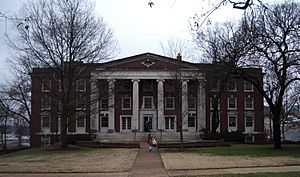
- Nashville: Confederate Memorial Hall at Vanderbilt University was renamed Memorial Hall in 2016. The university returned the original donation (adjusted for inflation) to the United Daughters of the Confederacy.
- Sewanee: Confederate flags were removed from the Chapel in the mid-1990s. A portrait of Leonidas Polk was moved in 2015. The Kirby-Smith Monument was moved to a graveyard in 2018.
Texas
- Arlington: Six Flags Over Texas theme park removed the Stars and Bars Confederate Flag in 2017.
- Austin:
* A plaque in the State Capital claiming the Civil War was not about slavery was removed in 2019. * Robert E. Lee Elementary School was renamed for photographer Russell Lee in 2016. * Jeff Davis Avenue was renamed for William Holland, an educator born into slavery. * Robert E. Lee Road was renamed for Azie Morton, the only African American to be Treasurer of the United States. * At the University of Texas, a statue of Jefferson Davis was moved to a museum in 2015. Statues of Robert E. Lee, Albert Sidney Johnston, and John H. Reagan were also moved to a museum in 2017.
* The Confederate War Memorial was removed in 2020 after legal battles. * John B. Hood Middle School was renamed Piedmont Global Academy in 2016. * The Robert E. Lee statue was removed in 2017 and later sold. * Stonewall Jackson Elementary School was renamed Mockingbird Elementary School in 2018. * Robert E. Lee Park was temporarily renamed "Oak Lawn Park."
* Dowling Street, named for a Confederate commander, was renamed Emancipation Avenue in 2017. * Jackson Middle School was renamed for community activist Yolanda Black Navarro in 2016. * Lee High School was renamed Margaret Long Wisdom High School in 2016.
- San Antonio: The Confederate Soldiers' Monument in Travis Park was removed in 2017. Robert E. Lee High School was renamed LEE (Legacy of Education Excellence) High School in 2017.
Utah
- St. George: The Confederate statue The Rebels at Dixie State University was removed in 2012.
Virginia
- Statewide: Confederate History Month was last celebrated in 2000. Lee-Jackson Day, a state holiday, was ended in 2020 and replaced with Election Day.
- Alexandria:
* A portrait of Robert E. Lee was moved from the City Council chambers to a museum in 2017. * Christ Church removed plaques honoring Washington and Lee in 2017. * The Appomattox statue was removed in 2020 by its owners, the United Daughters of the Confederacy.
- Arlington County: Jefferson Davis Highway was renamed Richmond Highway in 2019. Robert E. Lee's former home, Arlington House, was removed from the county's icon and seal in 2020 because it was built by enslaved people and owned by Lee.
- Bailey's Crossroads: J. E. B. Stuart High School, named for a Confederate general, was renamed "Justice High" in 2018.
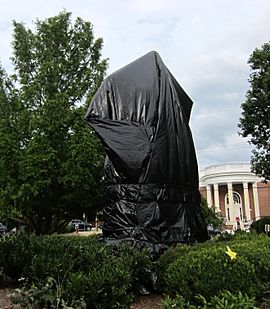
* Lee Park was renamed Emancipation Park in 2017, then Market Street Park in 2018. * The city council voted to remove the equestrian statue of Lee in 2017. This led to the violent Unite the Right rally. The statue was covered in black, then uncovered, and eventually removed in 2021. * Jackson Park was renamed Justice Park, then Court Square Park. * The University of Virginia removed two plaques honoring Confederate students and alumni from its Rotunda. * The At Ready statue of a Confederate soldier was taken down in 2020.
- Fairfax County: Former Robert E. Lee High School was renamed John R. Lewis High School in 2020.
- Lexington: The city banned flying flags other than the U.S. and Virginia flags on city light poles in 2011, which stopped the display of Confederate flags. A large Confederate battle flag was removed from the Lee Chapel at Washington and Lee University in 2014. Grace Episcopal Church, where Lee attended, changed its name back from R. E. Lee Memorial Church in 2017. Virginia Military Institute removed a statue of Confederate General Stonewall Jackson in 2020.
- Norfolk: The statue atop the Norfolk Confederate Monument was removed in 2020.
- Petersburg: Three schools named after Confederate figures were renamed in 2018.
- Portsmouth: The Confederate Monument was vandalized by protestors in 2020, leading to parts being removed.
* Monument Avenue: * The Jefferson Davis Memorial was pulled down by protestors in 2020. * The Stonewall Jackson Monument was removed by the city in 2020. * The statue of Matthew Fontaine Maury was removed by the city in 2020. * The J. E. B. Stuart Monument was removed by the city in 2020. * J.E.B. Stuart Elementary School was renamed Barack Obama Elementary School in 2018. * The Statue of Williams Carter Wickham was pulled down by protestors in 2020. * The Howitzer Monument was torn down by protestors in 2020. * Busts of Robert E. Lee and other Confederate leaders were removed from the Virginia State Capitol building in 2020.
Washington (state)
- Bellingham: Pickett Bridge sign, commemorating a Confederate supporter, was removed in 2017.
- Blaine: A stone marker for the "Jefferson Davis Highway" was removed in 2002 and moved to a private park.
- Everett: Part of Washington State Route 99, formerly the Jefferson Davis Highway, was renamed the "William P. Stewart Memorial Highway" in 2016, honoring an African-American Civil War volunteer.
- Seattle: The Robert E. Lee Tree and plaque were removed from Ravenna Park in 1926. The United Confederate Veterans Memorial was toppled by unknown persons in 2020.
West Virginia
- Charles Town: A bronze plaque honoring Confederate soldiers at the Jefferson County Courthouse was removed in 2018 after local groups called for its removal.
Wisconsin
* A flag pole used to fly the Confederate flag was removed from the Confederate Rest section of Forest Hill Cemetery in 2015. * A plaque and a larger stone monument honoring Confederate soldiers were removed from the cemetery in 2017-2019.
Worldwide Removals
As part of the global George Floyd protests, people have also removed or damaged statues of other historical figures who were involved in causing suffering, especially against Black people. For example, in Bristol, England, protestors pulled down a statue of Edward Colston, a slave trader. In Ghent, Belgium, protestors damaged a statue of King Leopold II, who was responsible for terrible acts in the Congo Free State.
Images for kids


